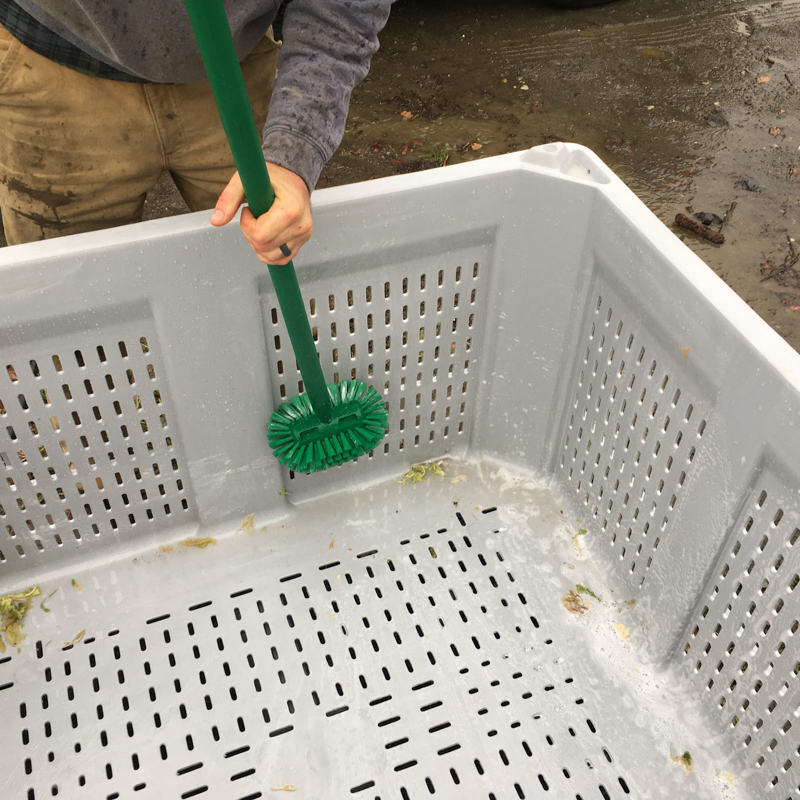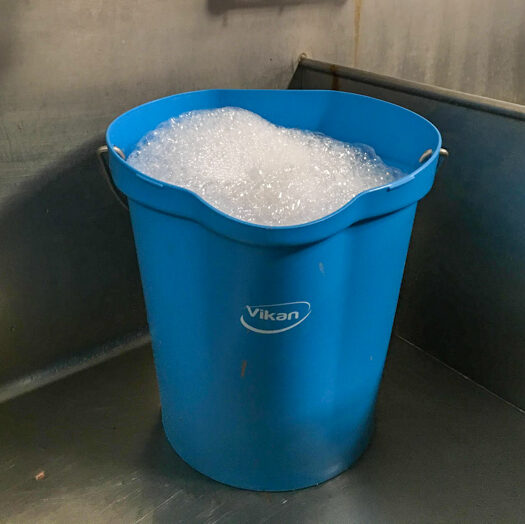Key Points
- An unscented, dye-free dish detergent is generally appropriate for food contact surface cleaning.
- Use just enough to see suds and get the surface visually clean; you know what clean looks like.
- Rinse off detergents unless the instructions say otherwise.
- Not sure about a product? Contact the manufacturer.
Introduction
In the Produce Safety Alliance Grower Training Course, the steps involved in cleaning and sanitizing food contact surfaces include using “an appropriate detergent.” The FSMA Produce Safety Rule, itself, requires:
§112.116(b) [food packaging]: If you reuse food-packing material, you must take adequate steps to ensure that food contact surfaces are clean, such as by cleaning food-packing containers or using a clean liner.
§112.123(d)1 [equipment and tools]: You must inspect, maintain, and clean and, when necessary and appropriate, sanitize all food contact surfaces of equipment and tools used in covered activities as frequently as reasonably necessary to protect against contamination of covered produce.
§112.123(d)2 [equipment and tools]: You must maintain and clean all non-food-contact surfaces of equipment and tools subject to this subpart used during harvesting, packing, and holding as frequently as reasonably necessary to protect against contamination of covered produce.
FSMA Produce Safety Rule (excerpted, emphasis added)
Well, What is an “Appropriate detergent for food contact surfaces?”
Don’t get confused by the word, “detergent.” A detergent really is anything that has the chemical ability (due to surfactants) to grab onto soil, oils, fats, or other filth with more strength than those things grab onto the surface being cleaned. This property of detergents helps remove the filth when you scrub the surface and wash the filth away when you rinse the detergent off the surface with water.
Soaps are simply a type of detergent. For most people, a detergent means a laundry detergent. Laundry detergents, which have only been tested to be used as directed (on laundry), are not an appropriate detergent for your food contact surfaces unless they are fabric. A few examples of appropriate detergents for hard, non-porous food contact surfaces are products you might have in your kitchen, like dishwashing soap. You can also find more specialized products from chemical suppliers.
Where’s the Label?
For sanitizers, you’ve probably heard a food safety educator say, “The label is the law!” since those chemicals pop up in EPA, FDA, and USDA regulations. Detergents are not regulated by the EPA, FDA, or USDA. The EPA regulates sanitizers and disinfecting products, but not soaps or detergents. The FDA has general requirements for using detergents in food contact areas (US FDA 2013 Food Code section 4-603.14) that basically say that what you’ve cleaned with a detergent needs to be rinsed afterward.
The USDA National Organic Program (NOP) requires that certified organic farms list all the detergents used for food contact surfaces and equipment in their organic system plan but that the detergent is not required to be organic since “detergents are designed to be rinsed off, and a subsequent rinse step is sufficient to prevent contamination of organic foods from synthetic cleaner residues.”
Bottom Line
Big takeaways here?
- Food contact surfaces are basically dishes. Unscented, dye-free dish detergents are generally appropriate for hard, non-porous food contact surface cleaning such as bins, tables, wash line surfaces, tools, etc.
- How do I know if it is OK? Concerned a product is not OK to use on your food contact surfaces? Contact the company and ask – we’ve contacted a few companies and received quick responses!
- A little goes a long way. There’s no need to make a bubble bath in your harvest bins, use just enough to see suds and get the surface visually clean. Rinse off the detergent as your last step, unless the instructions say otherwise.
- Trust your eyes. You know what clean should look like. Start with the simplest and most common dish detergents you can obtain. Avoid anything with dyes or odors since that may impact your produce. If you find that isn’t getting the surface clean enough, you may need a different cleaning tool or you may need to consider a more specialized detergent.
Please head on over to the SCRUB resource website for more resources, including fact sheets and videos about brushes, bins, and more.
Share This Post
Share this post using this shortlink: http://go.uvm.edu/detergents.
References
- Produce Safety Alliance (2019). Produce Safety Alliance Grower Training Course. Version 1.2. Cornell University. https://producesafetyalliance.cornell.edu/training/grower-training-courses/
- US FDA. (2013). US Food Code. https://www.fda.gov/food/fda-food-code/food-code-2013
- US FDA. (2015). FSMA Final Produce Safety Rule: Standards for the Growing, Harvesting, Packing, and Holding of Produce for Human Consumption. 21 CFR Parts 11, 16, and 112. US FDA. https://www.ecfr.gov/current/title-21/chapter-I/subchapter-B/part-112
- USA EPA. (2021) What’s the difference between products that disinfect, sanitize, and clean surfaces? https://www.epa.gov/coronavirus/whats-difference-between-products-disinfect-sanitize-and-clean-surfaces
- 3M Commercial Solutions. (2016) Tech Talk: Food Contact and Cleaning Products https://multimedia.3m.com/mws/media/1278716O/tech-talk-food-contact-and-cleaning-products.pdf
- USDA AMS. Allowed Detergents and Sanitizers for Food Contact Surfaces and Equipment in Organic Operations. https://www.ams.usda.gov/sites/default/files/media/8%20Cleaners%20and%20Sanitizers%20FINAL%20RGK%20V2.pdf (accessed June 26, 2022).
Acknowledgements
This guide was developed by Billy Mitchell (NFU), Chris Callahan (UVM Extension), Phil Tocco (MSU Extension), and Andy Chamberlin (UVM Extension) as part of the SCRUB Project.
This resource was developed as part of the Food Safety Outreach Program under grant number 2020-70020-33003 from the USDA National Institute of Food and Agriculture and also funded, in part, by the USDA Northeast Sustainable Agriculture Research and Education program through award LNE19-375 and by the Food and Drug Administration through The Vermont Agency of Agriculture Food and Markets via the Integrated Extension Educational Programming in Support of the VAAFM Produce Program Grant 02200-FSMA-2018-01. The views expressed in the publication do not necessarily reflect the official policies of the U.S. Department of Agriculture, the U.S. Department of Health and Human Services or the Vermont Agency of Agriculture; nor does any mention of trade names, commercial practices, or organization imply endorsement by the United States Government or the State of Vermont. It is offered without regard to race, color, religion, sex, sexual orientation, gender identity, national origin, disability, protected veteran status, or any other category legally protected by federal or state law.
This project was supported by the Food and Drug Administration (FDA) of the U.S. Department of Health and Human Services (HHS) as part of a financial assistance award 02200-FSMA-24-01 totaling $30,000 with 100 percent funded by FDA/HHS. The contents are those of the author(s) and do not necessarily represent the official views of, nor an endorsement, by FDA/HHS, or the U.S. Government.


